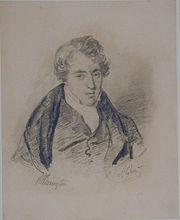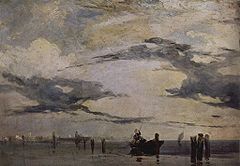
Richard Parkes Bonington
Encyclopedia

Landscape art
Landscape art is a term that covers the depiction of natural scenery such as mountains, valleys, trees, rivers, and forests, and especially art where the main subject is a wide view, with its elements arranged into a coherent composition. In other works landscape backgrounds for figures can still...
painter. One of the most influential British artists of his time, the facility of his style was inspired by the old masters, yet was entirely modern in its application.
Life and work

Arnold, Nottinghamshire
Arnold is a suburb of Nottingham, England. It is to the north-east of the city boundary, and is in the local government district of Gedling. It has only had a market since 1968, and had a number of factories associated with the hosiery industry...
, 4 miles from Nottingham
Nottingham
Nottingham is a city and unitary authority in the East Midlands of England. It is located in the ceremonial county of Nottinghamshire and represents one of eight members of the English Core Cities Group...
in England. His father was successively a gaoler, a drawing master and lace-maker, and his mother a teacher. Bonington learned watercolour painting from his father and exhibited paintings at the Liverpool Academy
Liverpool Academy of Arts
The Liverpool Academy of Arts was founded in April 1810 as a regional equivalent of the Royal Academy, London. Two local art collectors, Henry Blundell and William Roscoe were its first Patron and Secretary, the Prince Regent gave his patronage for the next three years, and it was actively...
at age 11.
In 1817, Bonington's family moved to Calais
Calais
Calais is a town in Northern France in the department of Pas-de-Calais, of which it is a sub-prefecture. Although Calais is by far the largest city in Pas-de-Calais, the department's capital is its third-largest city of Arras....
, France where his father had set up a lace
Lace
Lace is an openwork fabric, patterned with open holes in the work, made by machine or by hand. The holes can be formed via removal of threads or cloth from a previously woven fabric, but more often open spaces are created as part of the lace fabric. Lace-making is an ancient craft. True lace was...
factory.
At this time, Bonington started taking lessons from the painter François Louis Thomas Francia
François Louis Thomas Francia
François Louis Thomas Francia was a French painter born in Calais and famous for his shore landscapes. He was the master of the young British painter Richard Parkes Bonington....
, who trained him in English watercolour painting.
In 1818, the family moved to Paris to open a lace retail outlet. It was Paris where he first met Eugène Delacroix
Eugène Delacroix
Ferdinand Victor Eugène Delacroix was a French Romantic artist regarded from the outset of his career as the leader of the French Romantic school...
, who he became friends with. He worked for a time producing copies of Dutch and Flemish landscapes in the Louvre
Louvre
The Musée du Louvre – in English, the Louvre Museum or simply the Louvre – is one of the world's largest museums, the most visited art museum in the world and a historic monument. A central landmark of Paris, it is located on the Right Bank of the Seine in the 1st arrondissement...
. In 1820, he started attending the École des Beaux-Arts
École des Beaux-Arts
École des Beaux-Arts refers to a number of influential art schools in France. The most famous is the École nationale supérieure des Beaux-Arts, now located on the left bank in Paris, across the Seine from the Louvre, in the 6th arrondissement. The school has a history spanning more than 350 years,...
in Paris, where he studied under Antoine-Jean, Baron Gros.
It was around this time that Bonington started going on sketching tours in the suburbs of Paris and the surrounding countryside. His first paintings were exhibited at the Paris Salon in 1822. He also began to work in lithography, illustrating Baron Taylor
Baron Isidore Justin Séverin Taylor
Baron Isidore Justin Séverin Taylor was a royal commissioner of the Théâtre-Français. He was responsible for editing Voyages pittoresques et romantiques dans l'ancienne France, a celebrated collection of lithographed drawings and paintings....
’s "Voyages pittoresques dans l'ancienne France" and his own architectural series Restes et Fragmens". In 1824, he won a gold medal at the Paris Salon along with John Constable
John Constable
John Constable was an English Romantic painter. Born in Suffolk, he is known principally for his landscape paintings of Dedham Vale, the area surrounding his home—now known as "Constable Country"—which he invested with an intensity of affection...
and Anthony Vandyke Copley Fielding.
Bonington died of tuberculosis
Tuberculosis
Tuberculosis, MTB, or TB is a common, and in many cases lethal, infectious disease caused by various strains of mycobacteria, usually Mycobacterium tuberculosis. Tuberculosis usually attacks the lungs but can also affect other parts of the body...
on 23 September 1828 at 29 Tottenham Street in London, only 25 years old.

Nottingham Trent University, School of Art and Design
Founded in 1843, the School of Art and Design at Nottingham Trent University is one of the oldest in the United Kingdom and currently has more than 2,500 students.-History:...
by Fothergill Watson. A local primary school in his home town of Arnold is named after him.
Assessment
There is no finer nor more heartfelt evaluation of Bonington's work than that which Delacroix wrote in a letter to Théophile Thoré in 1861, and which reads, in part:"When I met him for the first time, I too was very young and was making studies in the Louvre: this was around 1816 or 1817...Already in this genre (watercolor), which was an English novelty at that time, he had an astonishing ability...To my mind, one can find in other modern artists qualities of strength and of precision in rendering that are superior to those in Bonington's pictures, but no one in this modern school, and perhaps even before, has possessed that lightness of touch which, especially in watercolors, makes his works a type of diamond which flatters and ravishes the eye, independently of any subject and any imitation."
"His name was Richard Parkes Bonington. We all loved him. I would sometimes tell him: "You are king of your domain and Raphael could not do what you do. Don't worry about other artists' qualities, nor the proportions of their pictures, since yours are masterworks."
Further reading
- Noon, P (2009). Richard Parkes Bonington : the complete paintings. New Haven, Yale University Press. ISBN 0 300 13421 5
External links
- Handprint.com – Biography by Bruce MacEvoy. Retrieved 17 November 2004.
- Examples of Richard Parkes Bonington's work

